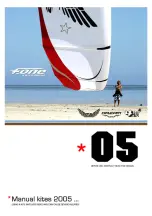
Turns
Nemo 5 is an agile wing, with smooth
reactions to all pilot’s actions. Handling is
actually easy and forces grow
proportionally to position of the brakes.
Adding some weight shift will make the
paraglider turn really quick and tight.
The combined technique (weight shifting
and brake input) is by far the most efficient
method of turning. Turn radius is then
determined by the amount of inside brake
used and weight shift. Additional
application a little outside brake after
initiating the turn with maximum weight
shift increases turn efficiency and the
outboard wing’s resistance to collapse (in
turbulence, the edge of a thermal etc).
In case of necessary turning in confined
area at slow speed (e.g. slope soaring), it is
recommended to steer the decelerated
canopy by loosening the brake at the
outside of the turn while applying just a
little more brake on the inside.
Caution:
when entering a turbulent area
you should brake a little to put up the
tension. It will allow you to react instantly in
case of a problem. Too hard or too quick
pulling of one brake can cause the wing to
enter a spin.
Thermalling and soaring
When flying minimum sink is reached with
slight brake pressure applied (
5 to 10 cm,
depending on pilot’s weight). I
n turbulent
conditions the canopy should be flown with
a small amount of brake applied. This
improves overall stability by increasing the
angle of attack of the canopy. The canopy
should neither rock back nor surge
forwards, but always stay above the pilot.
In order to achieve it, the pilot should
accelerate the canopy by letting off the
brakes when entering a thermal (according
to its strength) and brake it on exiting. This
is part of basic active flying that can spare
you many potential collapses.
When soaring the slope, minimum height of
50 m above the ground is recommended
for safety reasons. It is important to comply
with air traffic rules, especially when many
pilots share airspace close to the hill.
The avoidance manoeuvres often happen
to be impossible in such conditions.
Flying with speed-system engaged
When flying into head wind, through sink,
or during long transitions between thermals
it is advisable (for the sake of best glide
angle) to increase speed, as long as
14
Flight
NEMO















































